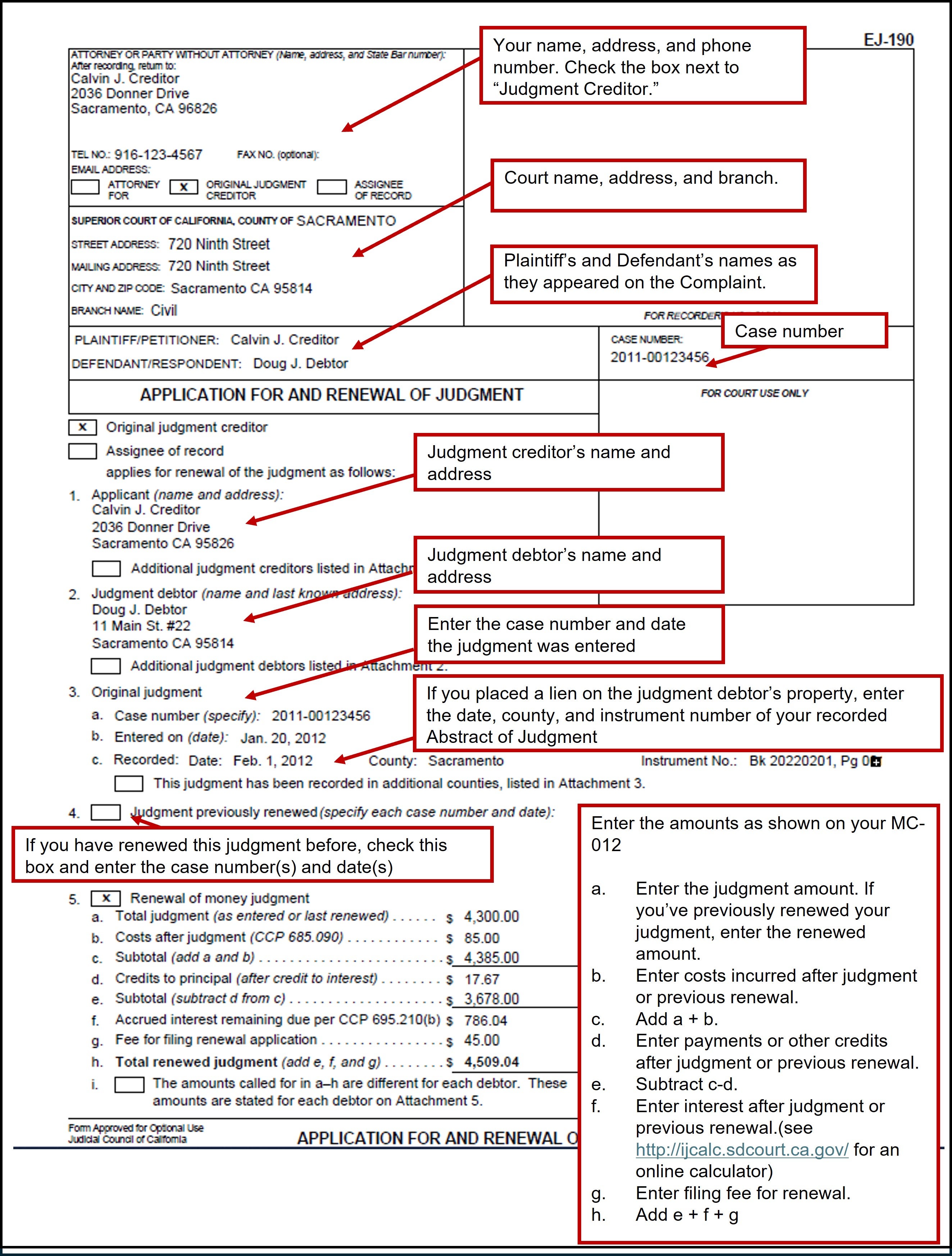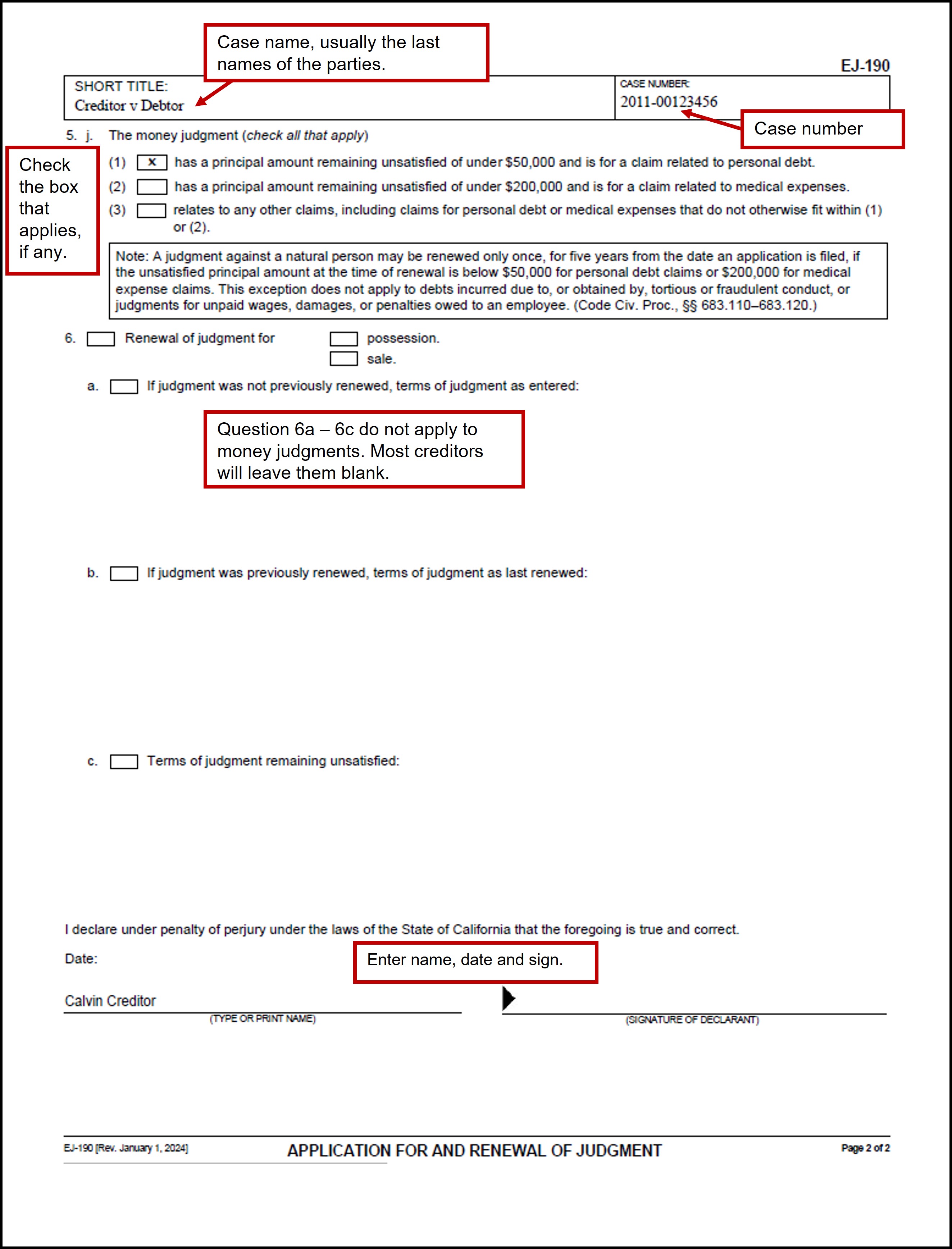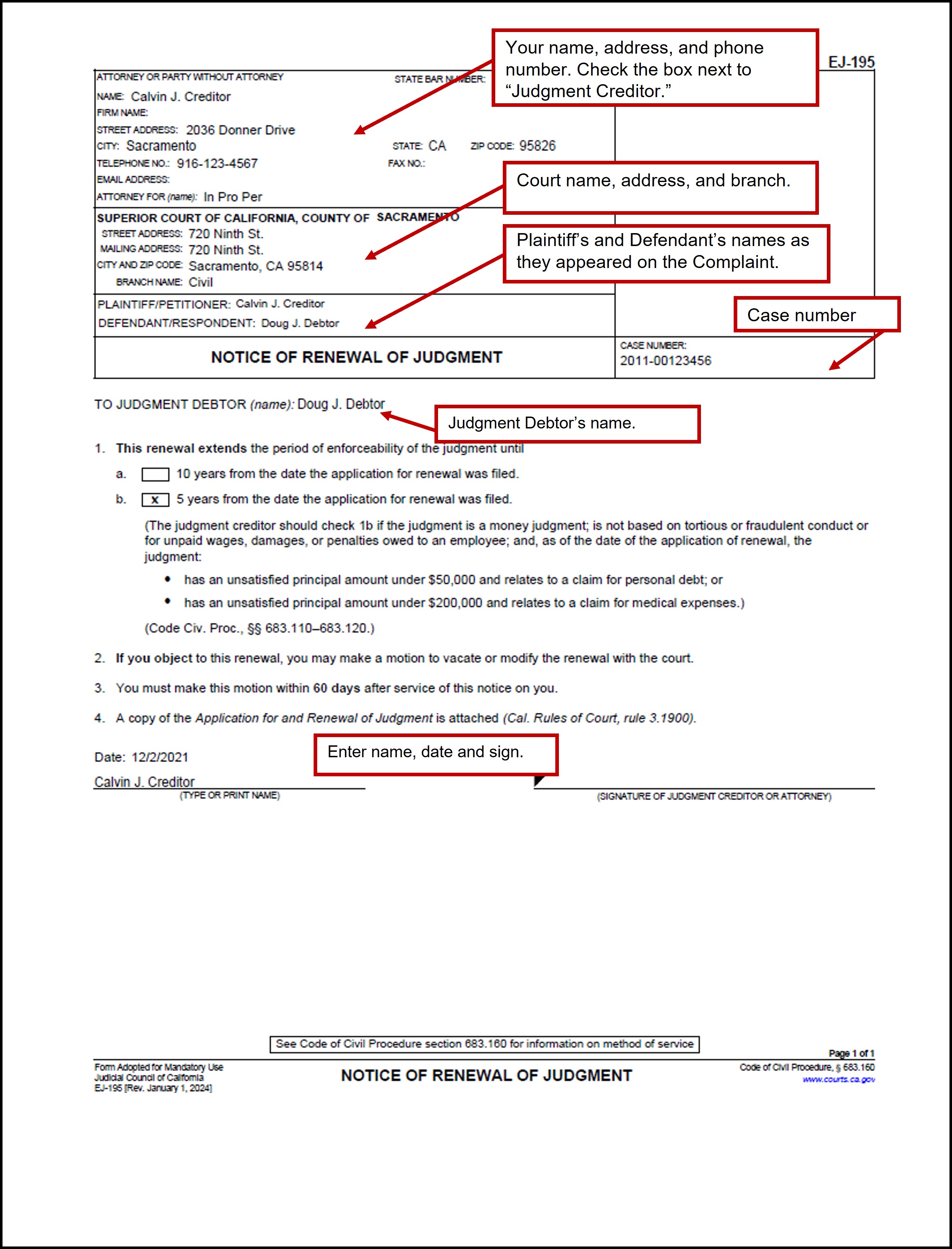Renewal of Judgment
Money judgments automatically expire after 10 years. Once a judgment expires, it is no longer enforceable, and the judgment creditor is not able to collect any unpaid judgment amounts. To prevent this from happening, the judgment creditor must renew the judgment before the 10 years run out.
Templates and Forms
The length and frequency of renewals depends on the type of judgment and the principle amount due:
- Money judgments for medical debt, where the principal amount owed is under $200,000 may be renewed once, for a period of 5 years. Interest on these judgments accrues at the rate of 5% per year for judgments entered or renewed after January 1, 2023. Interest on judgments entered or renewed before that date accrues at a rate of 10% per year.
- Money judgments for personal debt (e.g., credit cards, service contracts, personal loans, etc.) where the principal amount owed is under $50,000 may be renewed once, for a period of 5 years. Interest on these judgments accrues at the rate of 5% per year for judgments entered or renewed after January 1, 2023. Interest on judgments entered or renewed before that date accrues at a rate of 10% per year.
- All other civil judgments may be renewed for a period of 10 years and may be repeatedly renewed until the judgment is paid in full. Once these judgments are renewed, they cannot be renewed again until 5 years later. Interest on these judgments accrues at the rate of 10% per year. Some judgment creditors chose to renew these judgments every 5 years, rather than every 10 years, to compound the interest and maximize the amount they are owed.
Step-by-Step Instructions
Step 1: Locate the Judgment Debtor
In order to add costs and interest, and to begin collecting on a renewed judgment, you must serve the judgment debtor with papers. If you have been receiving regular payments from the judgment debtor, you likely know his or her current location. However, as time passes, it can become increasingly difficult to locate the judgment debtor. For tips on how to do this, see our guide on Finding People and Businesses.
Step 2: Complete the Memorandum of Costs after Judgment (MC-012)
In order to collect post-judgment costs and interest, you must file a Memorandum of Costs after Judgment (MC-012).
Step 2.1 Download and complete the form
The Judicial Council form used in this procedure is:
Instructions for completing this form are available from the Step-by-Step guide on Memorandum of Costs after Judgment.
Step 2.2 Make a copy
Make one (1) photocopy of your completed Memorandum of Costs after Judgment (MC-012).
Step 2.3 Serve your document
Have the photocopy of your Memorandum of Costs after Judgment (MC-012) served, either personally or by mail. Service must be made by someone over 18 who is not a party to your case. After service, your server must complete the Proof of Service on the second page of the Memorandum of Costs after Judgment (MC-012).
For more information on this procedure, including instructions for calculating interest and completing this form, see the Step-by-Step guide on Adding Costs and Interest to a Judgment on our website at saclaw.org/memo-costs-after-judgment.
Step 3: Complete the Renewal of Judgment Forms
To renew your judgment, you will need to complete two forms:
Sample completed forms with instructions are included at the end of this Guide.
Step 4: Make Photocopies
Make two (2) copies each of:
- Application for and Renewal of Judgment (EJ-190)
- Notice of Renewal of Judgment (EJ-195)
- Memorandum of Costs after Judgment (MC-012) with signed proof of service
Staple each set of photocopies, but leave the original documents unstapled. The originals will be scanned into the court’s filing system, and the staple will damage the scanner.
Step 5: File Your Documents
Your documents will be filed in the drop box in Room 100 in the Sacramento Superior Court at 720 Ninth Street. You must give the court the following items:
- Application for and Renewal of Judgment (EJ-190) (original + 2 copies)
- Notice of Renewal of Judgment (EJ-195) (original + 2 copies)
- Memorandum of Costs after Judgment (MC-012) with signed proof of service (original + 2 copies)
- Check or money order for the filing fee, currently $45 (check current fees on the Sacramento County Superior Court’s website)
- Self-addressed stamped envelope with sufficient postage to facilitate the return of your documents to you.
Fill out and attach the Civil Document Drop-Off Sheet, and date stamp the back of your original documents. A supply of Civil Document Drop-Off Sheets, Credit Card Authorization Forms, and a date stamp are located near the drop box. Following the instructions posted at the drop box, place the items listed above in the drop box.
Fee waivers generally expire 60 days after the entry of judgment in a case. If your fees were waived in your original case, you will need to reapply for a fee waiver. For more information, see the Step-by-Step guide on Fee Waivers.
After reviewing your documents, the clerk will “issue” (sign and stamp) your Notice of Renewal of Judgment (EJ-195), and return your forms to you by mail. These will become the new judgment in your case.
Step 6: Have Your Notice of Renewal of Judgment Served
Your judgment is renewed as soon as the clerk issues the Notice of Renewal of Judgment (EJ-195). However, you may not begin collecting on the renewed judgment until the judgment debtor is served with the following documents:
- Application for and Renewal of Judgment (EJ-190)
- Notice of Renewal of Judgment (EJ-195)
This may be done immediately after the judgment is renewed, or at any other time prior to beginning collections efforts. Service may be made in person or by mail. The server must complete a proof of service form, typically either a Proof of Personal Service (POS-020) or a Proof of Service by First Class Mail (POS-030). For more information, see the Step-by-Step guides on our website on Proof of Personal Service and Proof of Service by Mail.
The judgment debtor has 60 days after service to file a motion asking the court to vacate or modify the renewal of judgment. If the judgment debtor files this type of motion, you will be served with documents.
Step 7: Renew Liens
Any liens placed on the judgment debtor’s real property expire when the underlying judgment expires. Therefore, the lien must be renewed before the original judgment expires. To renew your lien, you must record a certified copy of your Application for and Renewal of Judgment (EJ-190) with the County Recorder in the county where the property is located. You may obtain a certified copy from the court clerk. Additional information is available at Civil: Obtain Status/Copies of Cases.
Step 8: Renew Collection Efforts
Your renewed judgment is enforceable for 10 years. If you have been enforcing your judgment with a Wage Garnishment or other method pursuant to a Writ of Execution (EJ-130), you will need to provide the levying officer with certified copy of your Application for and Renewal of Judgment (EJ-190). This will allow your enforcement proceeding to continue uninterrupted.
If you have not been actively enforcing your judgment, it is not too late to start! With a renewed judgment, you are able to use whatever collection methods are appropriate to collect what you are owed. For more information about the many enforcement procedures available to you, see our guide on Enforcement of Judgment.
For help
SH@LL (Self-Help at the Law Library)
609 9th Street, Sacramento CA 95814
(916) 476-2731 (Appointment Request Line)
Services Provided: SH@LL provides general information and basic assistance to self-represented litigants on a variety of legal issues. All assistance is provided by telephone. Visit “What we can help with” for a list of qualifying cases.
Eligibility: Must be a Sacramento County resident or have a qualifying case in the Sacramento County Superior Court.
For more information
On the Web:
California Courts Self-Help Website: “Renew your Judgment“
At the Law Library:
- California Practice Guide: Enforcing Judgments and Debts KFC 1065 .A9 S3
- Debt Collection Practice in California KFC 256 .C83
Electronic Access: On the Law Library’s computers, using OnLaw. - Enforcing Civil Money Judgments KFC 1065 .C34
Electronic Access: On the Law Library’s computers, using OnLaw. - How to Collect When You Win a Lawsuit in California KFC 1065 .Z9 H69 (Reference)
- Matthew Bender Practice Guide: California Debt Collection and Enforcement of Judgments KFC 1065 .E5 M38 Electronic Access: On the Law Library’s computers, using Lexis Advance.
Samples
Application for and Renewal of Judgment (EJ-190)


Notice of Renewal of Judgment (EJ-195)

This material is intended as general information only. Your case may have factors requiring different procedures or forms. The information and instructions are provided for use in the Sacramento County Superior Court. Please keep in mind that each court may have different requirements. If you need further assistance consult a lawyer.




